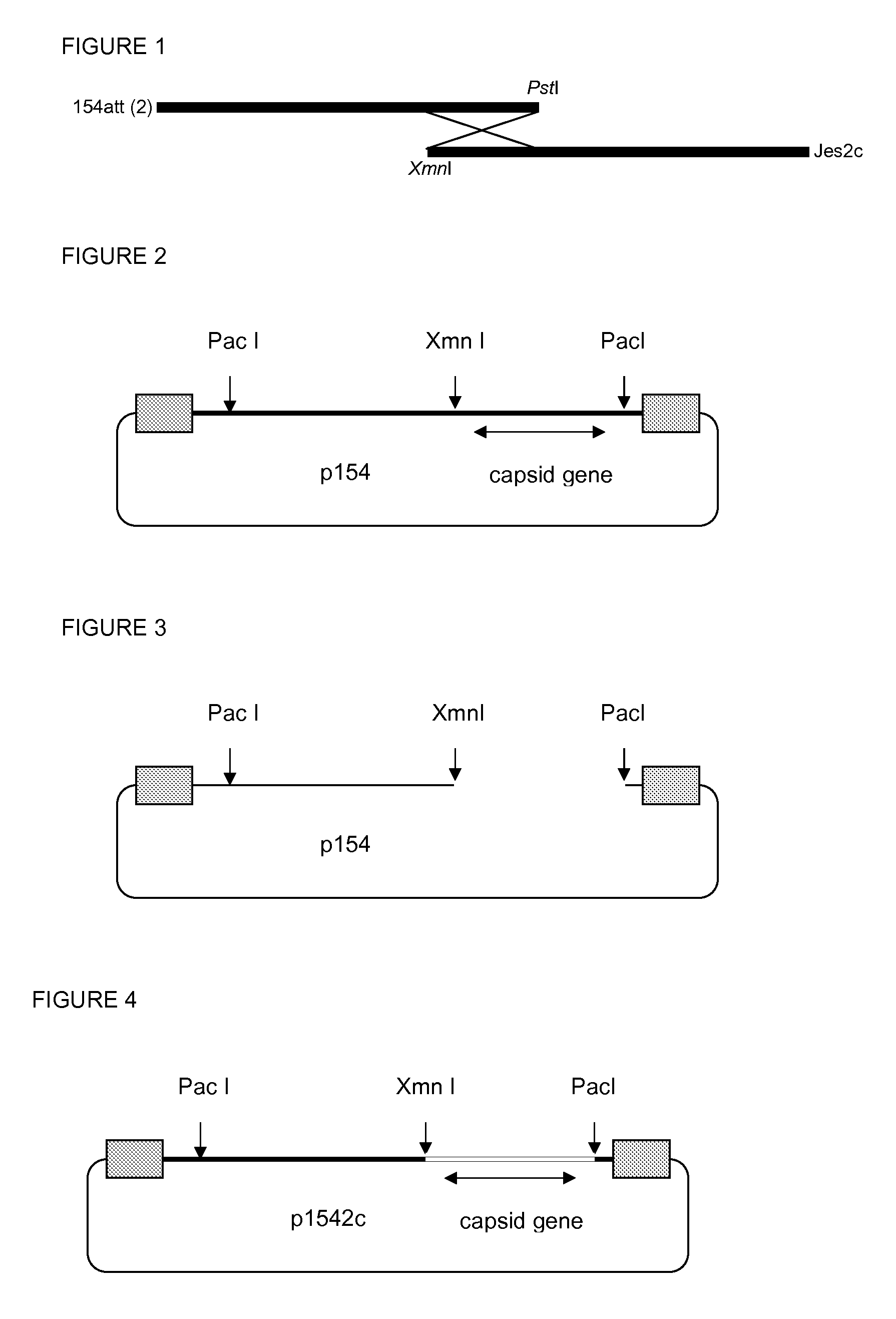Recombinant attenuated parvovirus
a parvovirus and recombinant technology, applied in the field of virus vaccines, can solve the problems of poor protection, short immunity duration, low white blood cell count, diarrhea, etc., and achieve the effect of good immunity and high titer
- Summary
- Abstract
- Description
- Claims
- Application Information
AI Technical Summary
Benefits of technology
Problems solved by technology
Method used
Image
Examples
example 1
Generation of Recombinant Virus
[0043]Strain 154 att was obtained from a commercially available Nobivac Parvo C (Intervet Schering-Plough Animal Health) and strain Jess was a field isolate of a type 2c virus.
[0044]Viruses were grown on adherent canine or feline kidney cells (eg A72 & CrFK) using M6B8 medium containing 5% foetal calf serum. Replicative form (RF) DNA was prepared from infected cell cultures using a modification of the standard “Hirt” method (McMaster et al 1981).
[0045]RF DNA prepared from the 154 att strain was digested with the restriction enzyme Pstl and the fragments separated by agarose gel electrophoresis. The 3055 base pair (bp) band (corresponding to the left hand end of CPV) was excised from the gel and purified using Qiagen Qiaquick gel extraction columns. RF DNA isolated from CPV Jess infected cells was digested with the restriction enzyme Xmnl. Again the DNA fragments were separated by agarose gel electrophoresis followed by purification of an approximately ...
example 2
Recombinant Virus Constructed from Cloned Viral DNA
[0048]Recombinant virus was generated from cloned fragments. The genome of virus strain 154att was cloned into the standard cloning vector pBluescript
[0049](Stratagene inc.). In order to maintain the palindromic terminal sequences intact the plasmid was propagated in the bacterial host DL795 which is defective in a number of recombination systems. Cloning of parvovirus genomes has been described in the literature and the techniques required are known to someone skilled in the art.
[0050]The obtained clone of 154att (p154) was digested with the restriction enzyme Pac I such that the digestion was not allowed to go to completion, i.e. the restriction enzyme digest was only partial. The digested fragments were then subjected to digestion with the restriction enzyme Xmn I. The digested DNA fragments were then separated by agarose gel electrophoresis and the fragment indicated in the diagram below was excised from the gel and purified usi...
example 3
In Vivo Testing
[0057]Three groups of 6 week old SPF non-vaccinated pups born from non-vaccinated mothers, hence devoid of any maternally derived antibodies directed against CPV were inoculated with the 2 / 2c hybrid virus, and each of the parental viruses (type 2 vaccine and type 2c field virus). Animals were clinically monitored and blood samples taken.
[0058]Group 1 contained 5 dogs subcutaneously vaccinated with Parvo C, a conventional Intervet vaccine comprising a type 2 CPV. Group 2 contained 5 dogs subcutaneously vaccinated with the new hybrid 2 / 2c vaccine at 107.5 TCID50 per ml.
[0059]It was found that the dogs in group 1 exhibited a higher titer of specific antibodies against type 2 virus than against the hybrid. Group 2 dogs on the contrary, exhibited higher titers of hemagglutination inhibition (HAI) as well as Serum Neutralisation (SN) titers against the hybrid virus.
[0060]It may therefore be concluded that the hybrid virus strain provides improved protection against infectio...
PUM
| Property | Measurement | Unit |
|---|---|---|
| length | aaaaa | aaaaa |
| full-length | aaaaa | aaaaa |
| antibody titer | aaaaa | aaaaa |
Abstract
Description
Claims
Application Information
 Login to View More
Login to View More - R&D
- Intellectual Property
- Life Sciences
- Materials
- Tech Scout
- Unparalleled Data Quality
- Higher Quality Content
- 60% Fewer Hallucinations
Browse by: Latest US Patents, China's latest patents, Technical Efficacy Thesaurus, Application Domain, Technology Topic, Popular Technical Reports.
© 2025 PatSnap. All rights reserved.Legal|Privacy policy|Modern Slavery Act Transparency Statement|Sitemap|About US| Contact US: help@patsnap.com


